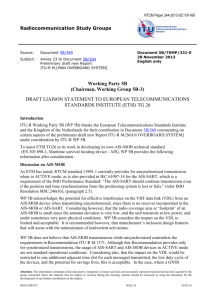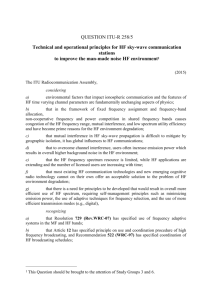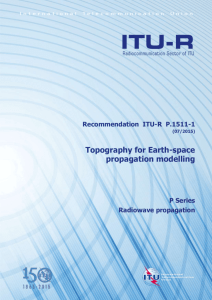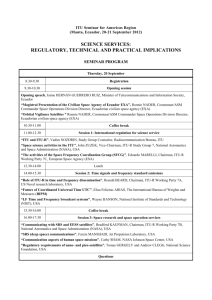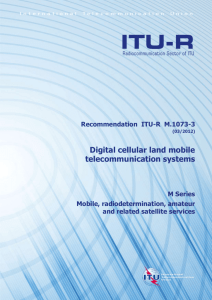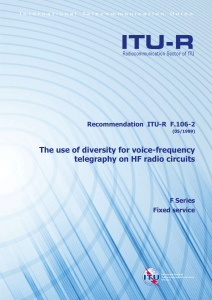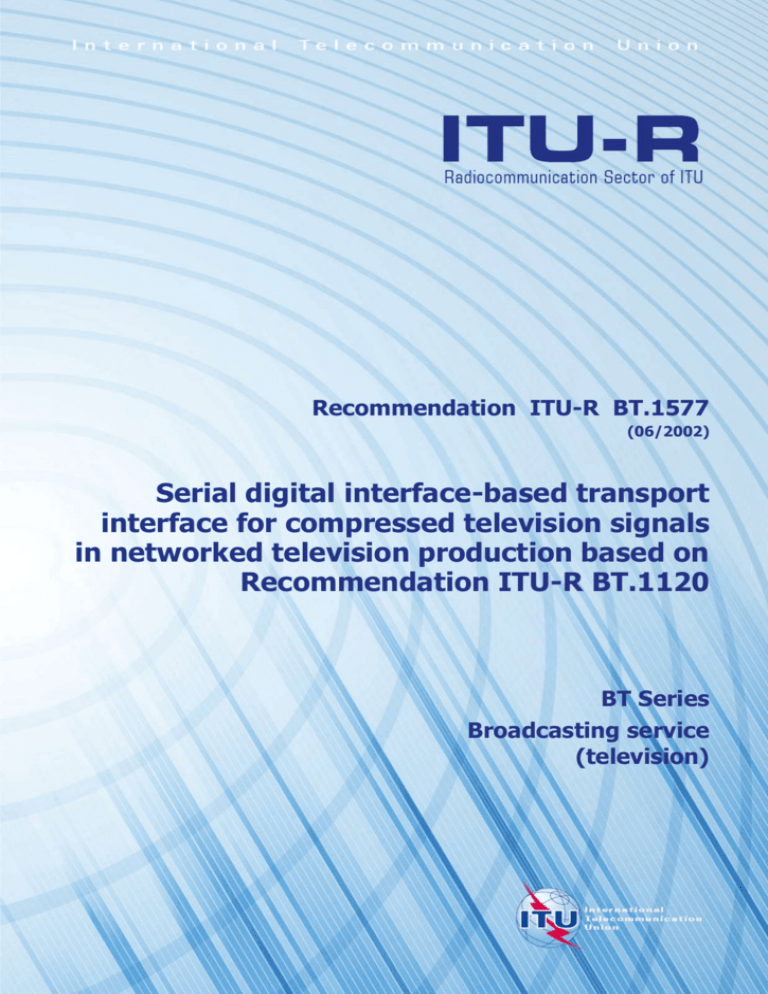
Recommendation ITU-R BT.1577
(06/2002)
Serial digital interface-based transport
interface for compressed television signals
in networked television production based on
Recommendation ITU-R BT.1120
BT Series
Broadcasting service
(television)
ii
Rec. ITU-R BT.1577
Foreword
The role of the Radiocommunication Sector is to ensure the rational, equitable, efficient and economical use of the
radio-frequency spectrum by all radiocommunication services, including satellite services, and carry out studies without
limit of frequency range on the basis of which Recommendations are adopted.
The regulatory and policy functions of the Radiocommunication Sector are performed by World and Regional
Radiocommunication Conferences and Radiocommunication Assemblies supported by Study Groups.
Policy on Intellectual Property Right (IPR)
ITU-R policy on IPR is described in the Common Patent Policy for ITU-T/ITU-R/ISO/IEC referenced in Annex 1 of
Resolution ITU-R 1. Forms to be used for the submission of patent statements and licensing declarations by patent
holders are available from http://www.itu.int/ITU-R/go/patents/en where the Guidelines for Implementation of the
Common Patent Policy for ITU-T/ITU-R/ISO/IEC and the ITU-R patent information database can also be found.
Series of ITU-R Recommendations
(Also available online at http://www.itu.int/publ/R-REC/en)
Series
BO
BR
BS
BT
F
M
P
RA
RS
S
SA
SF
SM
SNG
TF
V
Title
Satellite delivery
Recording for production, archival and play-out; film for television
Broadcasting service (sound)
Broadcasting service (television)
Fixed service
Mobile, radiodetermination, amateur and related satellite services
Radiowave propagation
Radio astronomy
Remote sensing systems
Fixed-satellite service
Space applications and meteorology
Frequency sharing and coordination between fixed-satellite and fixed service systems
Spectrum management
Satellite news gathering
Time signals and frequency standards emissions
Vocabulary and related subjects
Note: This ITU-R Recommendation was approved in English under the procedure detailed in Resolution ITU-R 1.
Electronic Publication
Geneva, 2011
ITU 2011
All rights reserved. No part of this publication may be reproduced, by any means whatsoever, without written permission of ITU.
Rec. ITU-R BT.1577
1
RECOMMENDATION ITU-R BT.1577*
Serial digital interface-based transport interface for compressed television
signals in networked television production based on
Recommendation ITU-R BT.1120
(Question ITU-R 130/6)
(2002)
Scope
This Recommendation provides a means to transport packetized compressed or uncompressed data over the
HDTV serial interface. The packetized data is identified with a unique identifier.
The ITU Radiocommunication Assembly,
considering
a)
that the high definition serial digital interface (HD-SDI) is being implemented in television
production studios and that it is documented in Recommendation ITU-R BT.1120;
b)
that Recommendation ITU-R BR.1356 – User requirements for application of compression
in television production, already exists;
c)
that maintaining video signals in compressed form as far as possible throughout the
production and post-production process offers the potential of increased operating efficiency;
d)
that programme data composed of audio, compressed video and metadata should be
streamed in a container commonly available in the high-definition production studio;
e)
that a transport mechanism must be established which allows point-to-point and
point-to-multipoint routing of these data through a digital production and post-production chain;
f)
that the transport should allow synchronous data transfer to facilitate absolute and relative
timing between programme data;
g)
that the transport mechanism should allow faster than real-time and non-real time transfer
of programme data,
recommends
1
that for applications based on the HD-SDI infrastructure in networked production and
post-production based on Recommendation ITU-R BT.1120 the high definition serial data transport
interface (HD-SDTI) described in Annex 1 should be used;
2
that compliance with this Recommendation is voluntary. However, the Recommendation
may contain certain mandatory provisions (to ensure, e.g., interoperability or applicability) and
compliance with the Recommendation is achieved when all of these mandatory provisions are met.
The words “shall” or some other obligatory language such as “must” and the negative equivalents
are used to express requirements. The use of such words shall in no way be construed to imply
partial or total compliance with this Recommendation.
*
Radiocommunication Study Group 6 made editorial amendments to this Recommendation in
October 2010 in accordance with Resolution ITU-R 1.
2
Rec. ITU-R BT.1577
Annex 1
SDI-based transport interface for compressed television signals
in networked television production
Introduction
This Recommendation specifies a data stream used to transport packetized data within a
studio/production centre environment. The data packets and synchronizing signals are compatible
with Recommendation ITU-R BT.1120 (see Fig. 1). This Recommendation describes the assembly
of two channels of 10-bit words multiplexed onto one HD-SDI line for the purpose of transporting
the data streams in a structured framework. The HD-SDTI data blocks and synchronizing signals
provide a data transport protocol that can readily be added to the infrastructure described in
Recommendation ITU-R BT.1120.
Recommendation ITU-R BT.1120 requires a sequence of 10-bit words which define a television
horizontal line comprising five areas in the following sequence (Note The first two areas are often
described together):
–
EAV: a 4-word unique timing sequence defining the end of active video (EAV) (of the
previous line);
–
LN/CRC: 2 words defining the line number (LN) followed by a 2-word cyclic redundancy
check (CRC) error detection code;
–
digital line blanking;
–
SAV: a 4-word unique timing sequence defining the start of active video (SAV); and
–
digital active line.
An associated television source format standard defines the rate of television horizontal lines by
defining the following parameters:
–
the number of words per line;
–
the number of words in the digital active line (and hence the number of words in the digital
line blanking period);
–
the number of lines per frame;
–
the number of frames per second.
Recommendation ITU-R BT.1120 currently defines several source formats. Recommendation
ITU-R BT.656 defines the meaning of the EAV and SAV word sequences which can be applied to
all relevant source formats.
A decoder compliant with this Recommendation shall not be required to decode all the source
formats available to Recommendation ITU-R BT.1120. The source formats that must be supported
by the decoder shall be specified in application recommendations.
1
HD-SDTI mapping onto HD-SDI
The source formats, in combination with Recommendation ITU-R BT.1120, describe the bit-serial
format formed from C/Y word-multiplexed channels as illustrated in Fig. 1.
Rec. ITU-R BT.1577
3
FIGURE 1
Arrangement of HD-SDTI wrapped around Recommendation ITU-R BT.1120
C data input
C data output
10 bits
Clock input
10 bits
HD-SDI
encoder
Serial data
Equalizer
Serial data
HD-SDI
decoder
Y data input
Clock output
Y data output
10 bits
10 bits
BT.1120
C data input
C data
8 (9) bits
Clock input
Y data input
8 (9) bits
C data
10 bits
HD-SDTI
formatter
Clock
C data output
10 bits
BT.1120
Y data
Clock
Y data
10 bits
10 bits
8 (9) bits
HD-SDTI
deformatter
Clock output
Y data output
8 (9) bits
HD-SDTI
1577-01
The HD-SDTI data shall be serialized, scrambled, coded, and interfaced according to
Recommendation ITU-R BT.1120 and the associated source format standard. The signal
specifications and connector types shall be as described in Recommendation ITU-R BT.1120.
The data word length shall be 10 bits defined as bits B0 through to B9. B0 is the least significant bit
(LSB) and B9 is the most significant bit (MSB). The order of bit-transmission shall be LSB first as
defined in Recommendation ITU-R BT.1120.
Source data shall be in groups of four 10-bit words representing a word-multiplexed CB, Y1, CR, Y2
signal, where CB and CR form one parallel C-data channel and Y1 and Y2 form a second parallel
Y-data channel.
The C/Y word clock rate shall be exactly 74.25 MWords/s for those picture rates which are an exact
integer number per second and shall be 74.25/1.001 MWords/s for those picture rates which are
offset by a divisor of 1.001.
The bit clock rate shall be 20 times the C/Y word clock rate (i.e., 1.485 Gbit/s or
1.485/1.001 Gbit/s).
The timing reference signals, EAV and SAV, shall occur on every line and shall be C/Y interleaved
as described in the source format document. The LN and CRC shall occur on every line and shall be
C/Y interleaved as described in Recommendation ITU-R BT.1120.
The HD-SDTI header data shall be encapsulated by an ancillary data packet according to
Recommendation ITU-R BT.1364 and placed in the data space between the end of the
EAV/LN/CRC and the beginning of the SAV.
The HD-SDTI payload shall be placed between the end of the SAV and the beginning of the EAV.
4
Rec. ITU-R BT.1577
There shall be space for two HD-SDTI header data and payloads per line. The first HD-SDTI
header data and payload shall use the C data channel and the second HD-SDTI header data and
payload shall use the Y data channel. The two channels shall be word multiplexed according to
Recommendation ITU-R BT.1120.
Each C/Y multiplexed line is treated as a separate HD-SDTI payload. Any line may carry an
HD-SDTI payload on either the C-channel or the Y-channel. Where a line carries both C-channel
and Y-channel payloads, the C-channel payload shall be assumed first in time, followed by the
Y-channel payload.
Figure 2 shows the data placement of the two HD-SDTI header data and payloads for one line.
FIGURE 2
C-channel
header
data
H-ancillary
space
SAV
EAV/LN/CRC
General layout of the dual-channel HD-SDTI header data and payload
Y-channel
header
data
H-ancillary
space
Y-channel ancillary data
C-channel payload area
SAV
EAV/LN/CRC
C-channel ancillary data
C-channel user data area
Y-channel user data area
Y-channel payload area
1577-02
2
Extended mode for constant payload data rate
The default HD-SDTI payload for each channel is the defined C/Y active line-channel period for
the source format at all picture rates. An optional extension mode allows source formats that would
otherwise reduce the payload data rate to advance the timing of the SAV marker so that the payload
data rate remains a constant value. In extended mode, the constant payload data rate value is either
exactly 129.6 Mbit/s or 129.6/1.001 Mbit/s depending on whether the frame rate of the source
format includes a 1.001 divisor. The payload lengths associated with particular source formats are
given in Table 1.
Rec. ITU-R BT.1577
5
TABLE 1
Payload length extension values for varying source frame rates
Frame rate
Lines per
frame
Samples per
line
Blanking
length
Payload
length
Payload rate
25
1 125
2 640
336
2 304
129.6 Mbit/s
24 (24/1.001)
1 125
2 750
350
2 400
129.6 Mbit/s
NOTE 1 – Not all equipment may support the extended mode. Users are cautioned to check whether
advancement of the SAV is supported by the HD-SDI infrastructure and the HD-SDTI decoder.
3
Double-rate operation
The source format may allow frequencies of double the baseline rate to accommodate the carriage
of progressively scanned pictures at the rates of 50 Hz, 60/1.001 Hz and 60 Hz for some source
formats.
The use of double-rate sampling frequencies is allowed within this Standard as a specified
extension. The effect is a doubling of the number of line-channels per second and there is no effect
on the data structure within each line-channel save doubling of the clock rates.
This is a significant extension of the source format capability and only specified equipment may
support this operation. Users are cautioned to check whether double clock rate is supported by the
HD-SDI infrastructure and the HD-SDTI decoder.
3.1
Header data specifications
For each line-channel carrying an HD-SDTI payload, HD-SDTI header data shall be encapsulated
by an ancillary data packet conforming to a Recommendation ITU-R BT.1364 ancillary data packet
structure (type 2) as shown in Table 2.
TABLE 2
HD-SDTI ancillary data packet structure
Name
Acronym
Value
Ancillary data flag (10-bit words)
ADF
000h, 3FFh, 3FFh
Data identification
DID
40h
Secondary data identification
SDID
02h
DC
2Ah
42 words
–
CS
–
Data count
HD-SDTI header data
Check sum
The total size of the ancillary data packet shall be 49 words of which the HD-SDTI header data
comprises the 42 words as shown in Table 3. The structure of the HD-SDTI header data packet is
further described in Fig. 3.
6
Rec. ITU-R BT.1577
TABLE 3
HD-SDTI header data
Name
Word length
Code and authorized address identifier (AAI)
1 word
Destination address
16 words
Source address
16 words
Block type
1 word
CRC flag
1 word
Reserved data
5 words
Header CRC
2 words
FIGURE 3
Header data structure
HD-SDTI header data ancillary data packet
Source
address
Reserved
(5 words)
Header
CRC (2 words)
Check sum
Destination
address
Block type
CRC flag
DID
SDID
Data count
AAI and code
ADF (3 words)
000h
3FF h
3FF h
140h
102h
12Ah
LN
CRC
EAV (3 words)
HD-SDTI header data
1577-03
HD-SDTI header data shall be located immediately after the EAV/LN/CRC sequence, as shown in
Fig. 3, on lines specified in the application document. In the special case of HD-SDTI applications
that embed digital audio according to Recommendation ITU-R BT.1365, the HD-SDTI header data
packets shall be placed immediately following any such Recommendation ITU-R BT.1365 ancillary
data packets.
For line-channels that do not carry an HD-SDTI payload, the Block Type shall be set to a value of
00h to indicate a null payload (plus definition of other header data).
All data in the HD-SDTI header data shall use 8-bit words using bits B0 to B7 of each word. For all
words of the HD-SDTI header data, bit B8 shall be the even parity of bits B0 to B7 and bit B9 shall
be the complement of bit B8.
4
Ancillary data formatting
The ADF, DID, SDID, DC and CS data words shall conform to Recommendation ITU-R BT.1364.
All data in the ancillary packet following the ADF shall be 8-bit words where the word value is
defined by bits B7 through B0; Bit B8 is even parity of bits B7 through B0 and bit B9 is the
complement of bit B8.
Rec. ITU-R BT.1577
4.1
7
Data ID (DID)
The data ID shall have the value 40h for bits B7 through B0.
4.2
Secondary data ID (SDID)
The secondary data ID shall have the value 02h for bits B7 through B0.
4.3
Data count (DC)
The DC shall represent 42 words for the header and have the value 2Ah for bits B7 through B0.
5
AAI and code
Both AAI and code shall consist of 4 bits (see Fig. 4).
AAI shall comprise bits B7 to B4.
Code shall comprise bits B3 to B0.
FIGURE 4
Assignment of AAI and code bits
B7
B6
AAI
B5
B4
B3
B2
Code
B1
B0
1577-04
5.1
AAI
The AAI shall identify the format of both the destination and source address words from one
of 16 different states.
TABLE 4
Assignment of payload size
Address identification
B7
B6
B5
B4
Unspecified format
0
0
0
0
IP-v6 addressing
0
0
0
1
The value 0h is reserved for applications where no source and destination address format is
specified. In this case, any non-zero value in the source and destination address shall be ignored.
8
5.2
Rec. ITU-R BT.1577
Code
“Code” shall identify the length of the payload which shall be contained in the area between the
SAV and EAV timing reference points.
TABLE 5
Assignment of payload size
Payload bits
B3
B2
B1
B0
SDI
0
0
0
0
1 440 words
0
0
0
1
1 920 words
0
0
1
0
1 280 words
0
0
1
1
Reserved for 143 Mbit/s applications
1
0
0
0
2 304 words (extension mode)
1
0
0
1
2 400 words (extension mode)
1
0
1
0
1 440 words (extension mode)
1
0
1
1
1 728 words (extension mode)
1
1
0
0
2 880 words (extension mode)
1
1
0
1
3 456 words (extension mode)
1
1
1
0
3 600 words (extension mode)
1
1
1
1
Reserved but not defined
All other codes
The value 0h is reserved to carry a line-channel of SDI signal in the active line-channel area.
Code values higher than 8h shall only be used if the HD-SDTI is being used in extended mode with
support for advanced SAV positioning as detailed in Table 1.
6
Destination and source address
The destination and source address represents the address of the devices within the connection
according to the AAI.
16 bytes are allocated for both destination and source address with the bit allocation for each
address as shown in Fig. 5.
Rec. ITU-R BT.1577
9
FIGURE 5
Assignment of payload size
A7
A15
A23
A31
A39
A47
A55
A63
A71
A79
A87
A95
A103 A111 A119 A127
A6
A14
A22
A30
A38
A46
A54
A62
A70
A78
A86
A94
A102 A110 A118 A126
A5
A13
A21
A29
A37
A45
A53
A61
A69
A77
A85
A93
A101 A109 A117 A125
A4
A12
A20
A28
A36
A44
A52
A60
A68
A76
A84
A92
A100 A108 A116 A124
A3
A11
A19
A27
A35
A43
A51
A59
A67
A75
A83
A91
A99
A107 A115 A123
A2
A10
A18
A26
A34
A42
A50
A58
A66
A74
A82
A90
A98
A106 A114 A122
A1
A9
A17
A25
A33
A41
A49
A57
A65
A73
A81
A89
A97
A105 A113 A121
A0
A8
A16
A24
A32
A40
A48
A56
A64
A72
A80
A88
A96
A104 A112 A120
1577-05
The default condition when neither destination nor source address is required is that all 16 bytes of
the destination and source addresses shall be set to 00h in accordance with AAI = 0h. When all
16 bytes of the destination address are zero filled in accordance with AAI = 0h, it shall indicate a
universal address to all destination devices connected to the interface.
7
Block type
The block type shall consist of one word comprising bits B7 to B0. The block type shall define the
segmentation of the payload. Either fixed block size or variable block size may be defined.
A block type value of 00h shall be used to indicate that the payload area does not contain an
HD-SDTI payload.
7.1
Fixed block type
B7 and B6 form the prefix to define the fixed block data structure as follows.
Fixed block size without error correction control (ECC):
Fixed block size with ECC:
B7
0
0
B6
0
1
Where the fixed block includes ECC, the ECC is contained within the fixed block data and the type
of ECC shall be defined by the application.
The possible segmentation of the fixed block size and the values for bits B5 to B0 are shown in
Table 6.
The first fixed block shall start immediately following the last word of the SAV for the
line-channel. Where more than one fixed block is present on a line-channel, the fixed blocks shall
form a contiguous string. Any space between the end of the last fixed block and first word of the
EAV shall be filled with the value 200h.
10
Rec. ITU-R BT.1577
TABLE 6
Payload segmentation for fixed blocks
Block type
01h
02h
03h
04h
09h
0Ah
0Bh
11h
12h
13h
14h
21h
22h
23h
24h
25h
26h
27h
28h
29h
7.2
Block size
1 438 words
719 words
479 words
359 words
1 918 words
959 words
639 words
766 words
383 words
255 words
191 words
5 words
9 words
13 words
17 words
33 words
49 words
65 words
97 words
129 words
Block type
Block size
2Ah
2Bh
2Ch
2Dh
2Eh
31h
32h
33h
34h
35h
36h
37h
38h
39h
3Ah
3Bh
3Ch
3Dh
3Eh
3Fh
193 words
257 words
385 words
513 words
609 words
62 words
153 words
171 words
177 words
199 words
256 words
144 words
160 words
1 278 words
1 726 words
2 302 words
2 398 words
2 878 words
3 454 words
3 598 words
Variable block type
The presence of a variable block size on the payload line-channel shall be indicated by the value
C1h. Thus bits B7 and B6 are set to 1 to define the presence of a variable block easily.
With a variable block, any size of consecutive block data words are permitted and the variable
block may extend beyond the length of one line-channel.
Where the variable block occupies more than one line-channel, the line-channels used shall be
contiguous and header data shall be repeated for all line-channels associated with the variable
block. The line-channels shall be considered as part of the contiguous sequence of a variable block
with the C-channel of any line preceding the Y-channel.
8
Payload CRC flag
The payload CRC flag shall consist of one word provided only for compatibility with
Recommendation ITU-R BT.1381. This word is redundant in HD-SDTI because the CRC words of
each EAV sequence are calculated from the first word of the payload to the last word of
the LN number.
The payload CRC flag word shall be set to 00h. All other values are reserved but not defined.
Rec. ITU-R BT.1577
9
11
Header expansion reserved data
The header expansion reserved data shall be positioned after the CRC flag. The default value for
the five reserved data words shall be 00h.
10
Header CRC
The header CRC shall be inserted following each ancillary data header. The header CRC applies to
all 10 bits of each word, starting with the DID word through to the last reserved data word.
The generator polynomial for the header CRC shall be:
G(X) = X18 + X5 + X4 + 1 (see Fig. 7).
The header CRC shall be contained in bits CRC17 through CRC0 as defined in Fig. 6, and the
initial value shall be set to all ones.
FIGURE 6
Header CRC bit definitions
9
0
8
7
6
5
4
3
2
1
(MSB)
(LSB)
B8
CRC8
CRC7
CRC6
CRC5
CRC4
CRC3
CRC2
CRC1
B8
CRC1
7
CRC1
6
CRC1
5
CRC1
4
CRC1
3
CRC1
2
CRC1
1
CRC1
0
CRC
0
CRC
9
BT.1577-06
FIGURE 7
CRC generator polynomial block diagram
C17 C16 C15 C14
+
C13
+
C12 C11 C10 C9 C8 C7 C6 C5 C4 C3 C2 C1 C0
+
Serial data input
1577-07
10.1
Payload data formats
HD-SDTI payload data may be present on any line-channel from the end of SAV to the beginning
of EAV. Some applications may constrain the use of certain line-channels.
Although data may exist on any line it should be noted that data may be corrupted during a switch.
11
Payload bit assignment
The payload data shall consist of either:
–
8-bit words contained in bits B7 to B0 with bit B8 set to be even parity of bits B7 to B0;
–
9-bit words contained in bits B8 to B0.
12
Rec. ITU-R BT.1577
The application shall define whether 8-bit or 9-bit inputs are used. It is recommended that 8-bit
input modes are used unless clear reasons for using the 9-bit input mode can be provided. The 9-bit
mode is provided primarily for backwards compatibility with Recommendation ITU-R BT.1381.
In all cases, bit B9 of each payload data word shall be set to the complement of bit B8 with the
exception of the separator and end-code words of variable blocks.
12
Data type
The data type shall consist of one 8-bit word contained in bits B7 to B0 for both fixed and variable
blocks.
TABLE 7
Data type
Type
101h
102h
203h
104h
205h
206h
107h
108h
209h
20Ah
10Bh
20Ch
10Dh
10Eh
20Fh
110h
211h
212h
113h
214h
115h
116h
217h
218h
119h
11Ah
21Bh
11Ch
21Dh
21Eh
11Fh
120h
Description
SXV
CP-System
CP-Picture
CP-Audio
CP-Data
SDTI-PF
Type
241h
242h
143h
244h
145h
146h
247h
248h
149h
14Ah
24Bh
14Ch
24Dh
24Eh
14Fh
250h
151h
152h
253h
154h
255h
256h
157h
158h
259h
25Ah
15Bh
25Ch
15Dh
15Eh
25Fh
260h
Description
DV CAM-1
HDCam
MPEG-2 P/S
MPEG-2 T/S
Rec. ITU-R BT.1577
13
TABLE 7 (continued)
Type
Description
Type
221h
222h
123h
224h
125h
126h
227h
228h
129h
12Ah
22Bh
12Ch
22Dh
22Eh
12Fh
230h
DVCPRO1/Digital S
DVCPRO2
161h
162h
263h
164h
265h
266h
167h
168h
269h
26Ah
16Bh
26Ch
16Dh
16Eh
26Fh
170h
131h
132h
233h
134h
235h
236h
137h
138h
239h
23Ah
13Bh
23Ch
13Dh
13Eh
23Fh
140h
HD-D5
271h
272h
173h
274h
175h
176h
277h
278h
179h
17Ah
27Bh
17Ch
27Dh
27Eh
17Fh
180h
281h
282h
183h
284h
185h
186h
287h
288h
189h
18Ah
28Bh
18Ch
SXA
1C1h
1C2h
2C3h
1C4h
2C5h
2C6h
1C7h
1C8h
2C9h
2CAh
1CBh
2CCh
Description
SXC
14
Rec. ITU-R BT.1577
TABLE 7 (continued)
Type
Description
Type
Description
28Dh
28Eh
18Fh
290h
1CDh
1CEh
2CFh
1D0h
191h
192h
293h
194h
295h
296h
197h
198h
299h
29Ah
19Bh
29Ch
19Dh
19Eh
29Fh
2A0h
2D1h
2D2h
1D3h
2D4h
1D5h
1D6h
2D7h
2D8h
1D9h
1DAh
2DBh
1DCh
2DDh
2DEh
1DFh
1E0h
FC
1A1h
1A2h
2A3h
1A4h
2A5h
2A6h
1A7h
1A8h
2A9h
2AAh
1ABh
2ACh
1ADh
1AEh
2AFh
1B0h
2E1h
2E2h
1E3h
2E4h
1E5h
1E6h
2E7h
2E8h
1E9h
1EAh
2EBh
1ECh
2EDh
2EEh
1EFh
2F0h
User application
User application
User application
User application
User application
User application
User application
User application
User application
User application
User application
User application
User application
User application
User application
User application
1F1h
1F2h
2F3h
1F4h
2F5h
2F6h
1F7h
1F8h
User application
User application
User application
User application
User application
User application
User application
User application
2B1h
2B2h
1B3h
2B4h
1B5h
1B6h
2B7h
2B8h
Up to 64
ITU-R BS 647
Audio/data channels
Rec. ITU-R BT.1577
15
TABLE 7 (end)
Type
1B9h
1BAh
2BBh
1BCh
2BDh
2BEh
1BFh
2C0h
13
Description
Type
2F9h
2FAh
1FBh
2FCh
1FDh
1FEh
2FFh
200h
Description
User application
User application
User application
User application
User application
User application
User application
Invalid data
Fixed block data structure
The fixed block data structure shall be as defined in Fig. 8 comprising of a 1-byte data type word
followed by the data block.
The data type word shall identify the type of data contained in the data block. The length of each
data block shall be identified by block type value contained in the header data and defined by the
length indicated in Table 6.
FIGURE 8
Data type
Data structure for fixed blocks
Data block
1577-08
14
Variable block data structure
The variable block data structure shall be as defined in Fig. 9. It shall comprise a 1-word separator,
followed by a 1-byte data type word, a 4-byte word count, the data block and terminating in a
1-word end-code.
FIGURE 9
-----
Word count
Data block
End code
Data type
Separator
Data structure for variable blocks
1577-09
If a variable block exceeds the length of one line-channel, the data shall continue over succeeding
line-channels until the end of the block. Header data must be consistent for all line channels which
carry a part of the same variable block.
16
Rec. ITU-R BT.1577
It is recommended that each and every variable block starts on a new line immediately following
the SAV.
Any space between the end code word of a variable block and either the start of a new variable
block or the first word of the EAV on the same line shall be filled with the value 200h.
14.1
Separator and end-code
Each variable block shall start with a 1-word separator and end with a 1-word end-code. The values
of separator and end-code shall be 10-bit words as follows.
Separator, 309h :
End-code, 30Ah :
B9
1
1
B8
1
1
B7
0
0
B6
0
0
B5
0
0
B4
0
0
B3
1
1
B2
0
0
B1
0
1
B0
1
0
Note that bit B9 of the separator and end-codes is not the complement of bit B8. These two codes
are registered values that break the normal HD-SDTI rules in order to guarantee their unique value
and hence provide unambiguous start and stop codes for each variable block.
14.2
Word-count
The word-count shall consist of four words as shown in Fig. 10. The word-count shall be used to
represent the number of words in the data block.
The word-count shall be contained in bits C31 through C0, and shall be interpreted as a single
32-bit unsigned integer with C31 as the MSB.
A word-count value of 00h, 00h, 00h, 00h shall be used to indicate either a variable block of
unknown length or a variable block whose length exceeds that of the word-count capability. In such
a case, the completion of a variable block is defined only by the reception of an end-code word.
FIGURE 10
Bit assignment of the variable block word-count
C7
C15 C23 C31
C6
C14 C22 C30
C5
C13 C21 C29
C4
C12 C20 C28
C3
C11 C19 C27
C2
C10 C18 C26
C1
C9
C17 C25
C0
C8
C16 C24
1577-10
It is the intent of this standard that all receiving equipment should attempt to receive data in a
variable block even if the word-count has a zero value.


